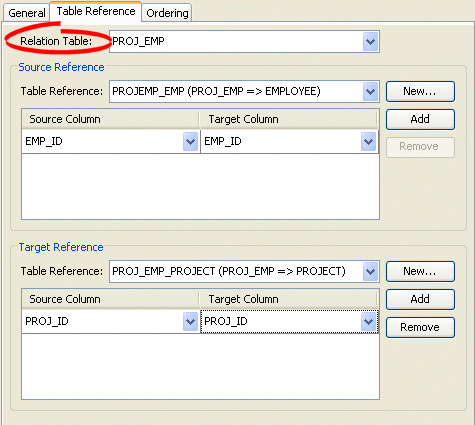Notice: This Wiki is now read only and edits are no longer possible. Please see: https://gitlab.eclipse.org/eclipsefdn/helpdesk/-/wikis/Wiki-shutdown-plan for the plan.
Configuring a Relational Many-to-Many Mapping (ELUG)
Contents
For information on how to create EclipseLink mappings, see Creating a Mapping.
This table lists the configurable options for a relational many-to-many mapping.
| Option to Configure | Workbench | Java |
|---|---|---|
|
Table and field references (Source) |
||
|
Table and field references (Target) |
||
This example shows how to create a many-to-many mapping and add it to a descriptor using Java code.
Many-to-Many Mapping
public void customize(ClassDescriptor descriptor) {
ManyToManyMapping mapping = new ManyToManyMapping();
// configure mapping
...
// add mapping to descriptor
descriptor.addMapping(mapping);
}
For more information, see the following:
For information on using JPA to configure many-to-many mappings, see @ManyToMany.
Configuring a Relation Table
The relation table contains the columns for the primary keys of the source table and target table involved in the many-to-many mapping. You must create this table in the database before completing the mapping. See Using Databases for information on creating database tables.
In the Many-to-Many Relationships figure, the PROJ_EMP table serves as the relation table between the PROJECT and EMPLOYEE tables.
How to Configure a Relation Table Using Workbench
To select a relation table for a mapping, use this procedure:
- Select the mapped attribute in the Navigator. Its properties appear in the Editor.
- Click the General tab. The General tab appears.
Table Reference Tab, Relation Table Option
- Use the Relation Table field to select a database table to define this mapping.
How to Configure a Relation Table Using Java
Many-to-many mappings represent the relationships between a collection of source objects and a collection of target objects. This requires an intermediate table that manages the associations between the source and target records.
Many-to-many mappings are instances of the ManyToManyMapping class and requires the following elements:
- The attribute mapped, set by using the setAttributeName method.
- The reference class, set by using the setReferenceClass method.
- The relation table, set by using the setRelationTableName() method.
- The foreign key information (for noncomposite target primary keys), which you specify by calling the setSourceRelationKeyFieldName and setTargetRelationKeyFieldName methods.
- The foreign key information if the source or target primary keys are composite, which you specify by sending the addSourceRelationKeyFieldName or addTargetRelationKeyFieldName methods.
Configuring a Relational Table
public void customize(ClassDescriptor descriptor) {
// In the Employee class, create the mapping that references Project class
ManyToManyMapping manyToManyMapping = new ManyToManyMapping();
manyToManyMapping.setAttributeName("projects");
manyToManyMapping.setReferenceClass(Project.class);
// Configure the relational table
manyToManyMapping.setRelationTableName("PROJ_EMP");
manyToManyMapping.setSourceRelationKeyFieldName ("EMPID");
manyToManyMapping.setTargetRelationKeyFieldName ("PROJID");
// Add mapping to descriptor
descriptor.addMapping(manyToManyMapping);
}
In addition to the API that Configuring a Relational Table illustrates, other common API for use with many-to-many mappings include the following:
- useBasicIndirection: implements EclipseLink value holder indirection.
- useTransparentCollection: if you use transparent indirection, this element places a special collection in the source object's attribute.
- dontUseIndirection: implements no indirection.
For more information about the available methods for ManyToManyMapping, see the EclipseLink API Reference.
